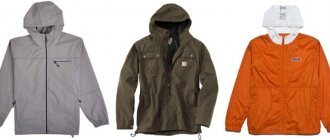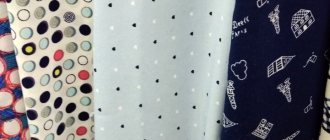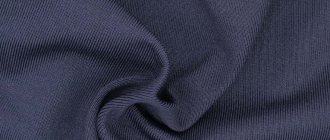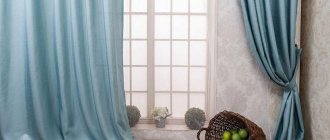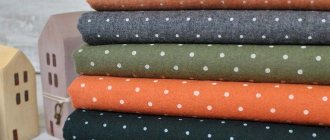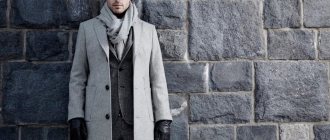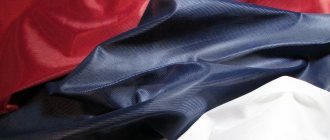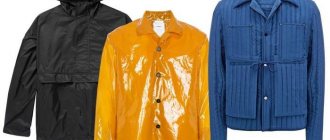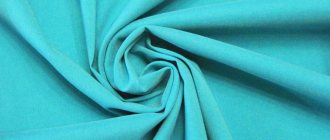Nylon - what kind of fabric: the properties of the material, its photo and detailed characteristics of nylon fabric can be found in our article. So, let's begin!
Nylon is a synthetic fabric made from polyamide fibers. This material was obtained even earlier than polyester, and with its appearance it revolutionized the world of women's fashion. Many of us have heard the name “nylon”, but not everyone understands what kind of fabric it is and what its properties are. Let's figure it out.
History of fabric
Nylon is the first synthetic fabric in the fashion world. The history of nylon began in 1935. American scientist Wallace Carothers, a leading chemist at the DuPont Corporation, was working on a material that could replace natural silk. In the process, he was able to synthesize a durable polymer resistant to aggressive environments from alcohol, water and coal tar. The substance is called polymer 6,6.
Nylon, created on the basis of a new substance, was officially presented to the public in 1939 at the World's Fair in New York in the form of women's stockings. Nylon stockings quickly became a bestseller, making millions of women happy.
The Second World War brought changes to the use of nylon. They had to forget about stockings; all the nylon produced was directed to the needs of the army. Parachutes, tents, awnings for military vehicles, and body armor were made from it.
Prices
The cost of the material, one of the incentives for popularity, is that both the fabric itself and the items made from it are affordable for everyone; these are economy class goods. The final price depends on the manufacturer, intermediary and composition; pure nylon is cheaper, enriched with spandex or natural fibers, somewhat more expensive. On average, for naked synthetics in bright colors, intended for sewing sportswear, outerwear or swimsuits, you will have to pay from 50 rubles per linear meter when purchased in bulk. At retail it’s a little more expensive, and if you’ve woven imitation lace or gone crazy with interesting decor, the price can jump up to 450 rubles per shoulder strap. Find out the scope of application of elastic and wear-resistant diving fabric by following the link.
How it is produced
- The threads used to create nylon fabric are obtained from a solution of polyamides as a result of complex chemical reactions. Acetic acid and amines are mixed and heated. The mixture forms a plastic that is formed into fine threads by extrusion and drawing.
- The fibers are used to weave cloth. Thin threads create a longitudinal base. On a loom, transverse weft threads are woven into it.
- The final stage is the processing of the finished raw material in the finishing industry: impregnation, reinforcement.
Raw materials and manufacturing process
Nylon is made from petroleum products. The chemical reaction is called polycondensation. Acids and aldehydes produce salt, which is heated. The resulting substance is thermoplastic, it is melted, pressed through special holes, dies, at the exit it turns into threads, which are immediately wound onto bobbins. The fiber for weaving is ready. It can be used to make stockings and parachute fabric - the result depends on the weaving pattern, thread density, and additives.
Fact. Thread density is measured in denier, den is the weight in grams per 9 km of length.
Application of nylon
Nylon is created chemically. You shouldn't be afraid of this. The material meets all sanitary and hygienic standards, is safe for use and has a wide range of applications.
Household nylon is used as an independent material or as blending additives for the production of clothing and accessories. It is suitable for sewing:
- outer and casual clothing - jackets, windbreakers, raincoats, blouses, T-shirts, dresses, trousers;
- hosiery;
- underwear and bedding - pajamas, shirts, linen sets, swimsuits;
- accessories - bags, backpacks, umbrellas;
- tourist accessories - tents, awnings, sleeping bags;
- sportswear , including for extreme sports;
- workwear - aprons, protective overalls, life jackets;
- home textiles - curtains, bedspreads, furniture covers, carpets.
Industrial nylon is used for technical purposes, reinforced with fiberglass, graphite, and serves as raw material for a variety of bushings, films, coatings, and packaging.
What is nylon made from?
Due to its practicality and ease of care, a huge variety of useful things are made from nylon. There are two types of this material - household and industrial.
From household nylon they sew:
- lingerie (slips, nightgowns, panties and bras);
- socks, stockings, tights (despite their thinness and lightness, nylon products successfully protect the legs from the cold);
- casual clothes (T-shirts, pants, dresses);
- jackets and windbreakers;
- backpacks;
- tourist and sports equipment;
- workwear (aprons, protective overalls);
- home decor items (curtains, curtains, bedspreads);
- various cases.
For industrial needs, nylon is rarely used in its pure form. It is reinforced with fiberglass or reinforced with graphite to increase strength. Industrial nylon is used for films, bushings, coatings, inlays, and guitar strings.
During wartime in America, tents and body armor were made from nylon, cables and panels for parachutes were made.
Description, properties and types of nylon
The peculiarity of nylon is that it does not withstand high temperatures well: under their influence, nylon melts and deforms.
Nylon fibers are easily dyed in any color; the fabric offers a variety of possible colors and shades.
Nylon is not a warm material; it does not provide warmth or retain heat. But it also does not allow cold air to pass through, and is often used as a lining for outerwear, protecting against wind and blowing.
The material has a smooth silky structure.
Pure nylon without additives does not stretch. Lycra is added to the fibers for elasticity.
Kinds
Nylon is not just one type of fiber. This is the general name for the family of polyamides:
- Anid.
- Capron.
- Enant.
- Undecan.
There are other trade names adopted in different countries: Perlon, Dederon, Ultramid, Akulon, Nilatron, Alphalon, Tarnamid.
The first two, anide and nylon, are the most popular.
Varieties by type of weaving and additional processing:
Cordura. Characterized by increased strength. This is inherent in the very structure of the fabric, which makes it 4 times stronger than regular nylon. The material is also coated with a layer of silicone or polyurethane. Sometimes it contains 10% cotton, which makes the surface of the fabric more matte. Initially used for the needs of the army, today it is used for tents, awnings, bags, belts, covers.
Ripstop. The fabric does not unravel, even if there are through holes, thanks to reinforced threads woven at a short distance from each other.
Nylon with silicone or polyurethane coating: Taffeta, HD Nylon, Nylon 6.6 Ripstop Silicon. Waterproof, highly tear-resistant material for outdoor, marine or military applications. Thick ones are used to make backpacks, tents, trim car interiors, and upholster furniture. Many species are light in weight with relatively high strength. They are used to make outerwear for children and adults, camouflage, curtains, and ski suits.
Mixed fabric NC (nylon + cotton). Lightweight, wrinkle-resistant, breathable, and meets increased hygienic requirements. Used for sewing shorts, trousers, uniforms, hats.
Elastic nylon. Elastomers, polymers with high elongation but low strength, are added to nylon fiber. The most famous is elastane. Other names: lycra, spandex. The second way to make nylon elastic is the springy texture of the fiber. Elastic nylon is widely used to make sportswear. It provides a good fit and does not interfere with dynamics during active movements.
Technical nylon. Reinforced with graphite, fire-resistant fibers, fiberglass. Used in industry, for the manufacture of fishing equipment, packaging, containers.
Water repellent properties
- Taslan Offoman 100% provides maximum protection against moisture. This is a durable lightweight material, porous in structure, repels moisture and dirt from the surface.
- Complex Finetex 100% is a membrane material of increased strength with a high degree of protection against moisture. The porous protective layer allows air to pass through. Provides dryness and comfort in extreme conditions. Moisture resistance 5000 mm.
- Finetex is a 100% two-layer membrane fabric with a finely porous inner surface that prevents water from entering, is tear-resistant, and allows the body to breathe. Moisture resistance 2000 mm.
- Elide 100% is a soft, lightweight, durable, thin membrane material. Does not allow water to pass through and allows air to circulate. Has high elasticity.
Use in 3D printing
Taulman brand nylon filaments are available in diameters of 1.75mm and 3mm.
Printing technology using nylon is similar to printing with ABS plastic, but with some differences. Like ABS plastic, nylon is prone to curling and warping when unevenly cooled, requiring the use of a heated bed.
The layers of nylon adhere perfectly, which minimizes the likelihood of models delaminating. Users of Taulman plastics note the durability of models at the level of analogues made by traditional injection molding.
Nylon is practically resistant to gluing, which makes it difficult to manufacture large parts from composite parts. Alternatively, it is possible to join nylon parts by melting the joined surfaces.
Nylon can be dyed using acid-based dyes.
Nylon does not adhere to glass and other smooth surfaces, so when printing it is recommended to apply masking tape to the work table or use a wood backing.
Due to the high hygroscopicity of nylon (ability to absorb moisture), it is recommended to dry nylon threads immediately before printing. Otherwise, water vapor may be released from the nozzle, which is not catastrophic for the extruder, but may affect the print quality.
Advantages and disadvantages
Positive properties of nylon:
- strength - the material does not tear and can withstand heavy loads;
- resistance to deformation and wear - the fabric does not wrinkle, does not stretch at the elbows and knees, does not thin at the bends, does not fade, and retains an attractive appearance for a long time;
- smoothness;
- elasticity;
- ease of care - dries quickly, does not require ironing, does not require special storage conditions.
Synthetic fibers in the composition increase the service life of products, resist deformation, reduce wrinkles, and add practicality, convenience and comfort to things.
Disadvantages of the material:
- does not allow air to pass through;
- does not absorb moisture like cotton;
- causes allergies and irritation to the skin, not suitable for use by people with skin diseases;
- vulnerable to high temperatures and ultraviolet radiation;
- electrified.
Qualitative characteristics
Characteristics of nylon:
- Easily accepts various dyes. The palette is not limited.
- Permanent color, coloring occurs during the technological process.
- Tensile strength. In its pure form it hardly stretches. To obtain plastic materials, it is combined with elastane.
- Resistance to mechanical and chemical influences. Has a low coefficient of friction. Insoluble in organic solvents, weak acids, alkalis, and not affected by salt water.
- Inertia. It does not cause allergies and does not in itself have a negative effect on the skin.
- Susceptible to high temperatures. When heated in air to +100… +120 °C, its strength decreases by 5-10 times.
- Doesn't wrinkle. Items need ironing only in certain cases.
Moisture permeability
Nylon repels moisture, does not allow it to pass through, and does not get wet. Moisture permeability of the finished product may occur, but this depends on the weaving and additional processing, and not on the quality of the material itself. For example, Oxford has a three-layer polyurethane coating, and UV-PU is coated with polyurethane on the inside, which provides water resistance of up to 2000 mm.
Nylon Taffeta with 4 layers of polyurethane withstands 10,000 mm of water column.
Extensibility degree
The stretchability of nylon is not comparable to elastane, which can stretch up to 600%. Nylon, when stretched by 16%, is irreversibly deformed by 9%. When stretched by 8%, nylon retains its original quality by 100%. The stretchability of nylon is not noticeable in the finished product, but in technological processes this parameter is taken into account. If you wind the threads onto bobbins with enough tension, the thread will tend to return to its original length and may crush the bobbins.
Author:
Anastasia Kukushkina
I hope you enjoy the article I have prepared for you! If you find errors in it, write to me about it! I will answer any questions you have, ask them!
